Infrastructure, Design, Environment and Sustainability
Environmental research and academic programs extend back to the very beginnings of the Lee College of Engineering’s civil engineering program, which in its earliest days was actually called Urban and Environmental Engineering. Steps towards more formally organizing environmental research and education started with the creation of the Global Institute for Energy and Environmental Systems (GIEES) in 2001, followed by the establishment of the Infrastructure and Environmental Systems (INES) doctoral program in 2004, the renaming of Civil Engineering as Civil and Environmental Engineering in 2007, and then the evolution of GIEES into the Infrastructure Design Environment and Sustainability (IDEAS) Center in 2010.
GIEES
UNC Charlotte took the first step toward building a campus-wide environmental engineering and science program in 2001, when it hired Hilary Inyang. Demonstrating the university’s desire for environmental research to by interdisciplinary, Inyang was hired into a joint appointment shared between Civil Engineering and Geography and Earth Science.
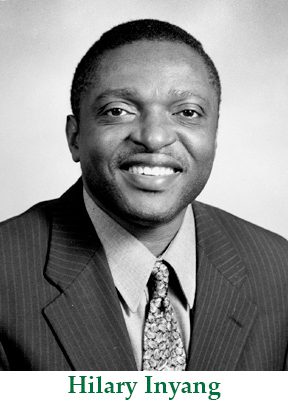
Inyang came to UNC Charlotte from the University of Massachusetts-Lowell, where he was the founding director of the Center for Environmental Engineering, Science and Technology. Inyang’s position at UNC Charlotte was that of the Duke Energy Distinguished Professor of Environmental Engineering and Science, which was funded with financial support from Duke Energy. Duke also contributed more than $500,000, as part of a $10 million donation in support of the Charlotte Institute for Technology Innovation (later CRI), to build laboratories for the new environmental program.
Inyang’s initial plans included winning state support to establish an environmental-based doctoral program, building a Geo-environmental and Energy Systems Research Laboratory, and establishing the Global Institute for Energy and Environmental Systems (GIEES).
The programs began in the C.C. Cameron Center Applied Research Center on the UNC Charlotte campus, a facility dedicated to advanced interdisciplinary research. UNC Charlotte departments involved included Civil Engineering, Engineering Technology, Electrical and Computer Engineering, Geography and Earth Science, Architecture, Biology, Economics and Community Relations. Initial research focus areas included disaster response and mitigation, water and air quality, compliance issues, waste disposal and landfills.
Two new Civil Engineering faculty members involved with the program had come with Inyang from the University of Massachusetts-Lowell. They were Vincent Ugunro and John Daniels.
Daniels came to UNC Charlotte directly after completing his Ph.D. “We didn’t have the resources to be great in every single research area,” he said, “and we had to be selective in our focus areas. The area where UNC Charlotte was growing excellence was in geo-environmental engineering, at the interface of geotechnical engineering and environmental engineer. This included things like groundwater, groundwater contamination, remediation, landfills, and industrial by-products such as fly ash. That’s what attracted me here. The chance to be part of such a team.”
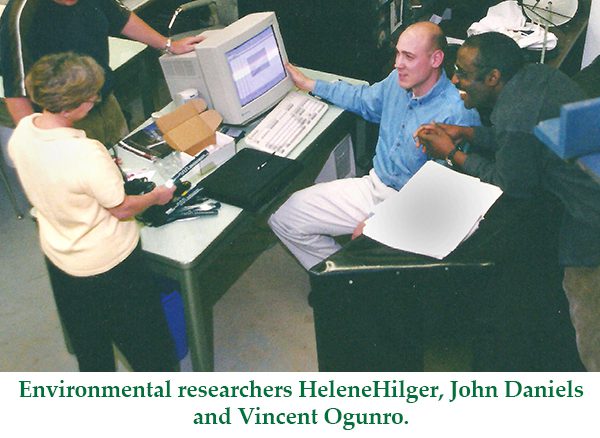
The stated mission of the program was to conduct research and provide technical support to the private sector, public agencies, community-based organizations and academic institutions on environmental issues pertinent to urban/regional growth, energy infrastructure development, industrial activities and natural disaster mitigation. Engineering collaborators initially involved included Helene Hilger, Alan Stadler, Jim Bowen and Jy Wu, in addition to Inyang, Daniels and Ogunro.
In 2004, UNC Charlotte was successful in winning approval of a new Ph.D. program to support upper-level environmental education and research. The Infrastructure, Environment and Sustainability (INES) doctoral program focused on the interrelationship between infrastructure and the environment at a systems level. Students concentrated their studies on design, analysis and management.
The Lee College of Engineering’s growing commitment to environmental engineering was further demonstrated in 2007, when the Civil Engineering Department changed its name to Civil and Environmental Engineering. The name change reflected the department’s growing number of undergraduate environmental engineering technical elective courses and projects, as well as the growing research of GIEES.
With a number of international relationships, GIEES was successful in sharing environmental research and learning throughout the world through post-doctoral exchange programs and international conferences. Examples included the Global Alliance for Disaster Reduction, which held its kickoff conference in Charlotte in April 2002. An alliance of 180 cooperating organizations from throughout the world, representatives presented research in the areas of natural hazard research, seismology, emergency management, information technology and other related disciplines. GIEES also hosted the International Conference on Energy, Environment and Disaster conference as part of the INCEED international series focused on global sustainable development issues
The economic downturn in 2008 limited the travel resources of many universities, though, and environmental leaders at UNC Charlotte decided to change the program’s emphasis to a more regional focus. Inyang soon after got the opportunity to become vice chancellor and distinguished professor at the Botswana International University of Science and Technology, and left UNC Charlotte.
IDEAS
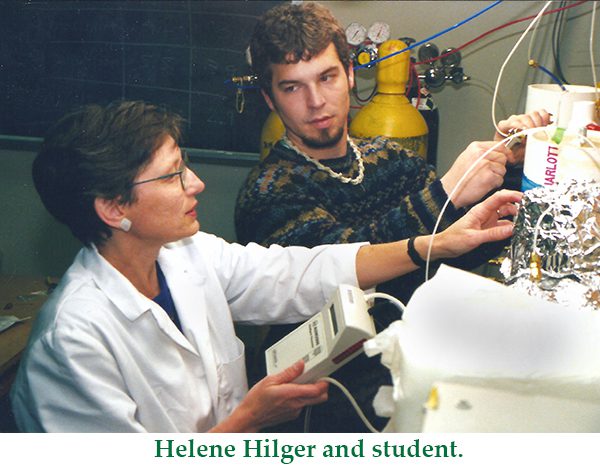
Helene Hilger of Civil and Environmental Engineering took over as the director of UNC Charlotte’s environmental research program in 2010. Her first task was to reorganize and refocus the direction and scope of the group.
“GIEES did very well in the beginning,” Hilger said, “but at the university level had become somewhat of a political hot potato. GIEES tried to hold more conferences to make money, but they did terrible. Inyang said the Provost promised annual money to support the program, but that got cut. Inyang also felt he wasn’t getting the support from (Steve) Mosier (director of university research). At that point Inyang stepped down and GIEES went away.”
To get UNC Charlotte’s environmental program back on its feet, Hilger decided to focus it on sustainability. The name of the research center was changed from GIEES to the Infrastructure, Design, Environment and Sustainability (IDEAS) center. IDEAS researchers began concentrating their research expertise on solving problems that arose from the complex relationships between humans and their environment.
“The purpose of creating the IDEAS Center was to provide a venue for the university to use its expertise to respond to environmental and sustainability challenges and contribute viable solutions,” Hilger said. “IDEAS represented the recognition that there are new criteria for good community and global citizenship, and we wanted to teach these criteria to students so they could learn to use them in their future engineering careers as planners and designers.”
Hilger described herself as a “grow-your-own” faculty member. She had come to Charlotte with her husband, who was a psychology faculty member at UNC Charlotte. She had her bachelor’s degree in biology and the time, and from 1978-1982 earned her second bachelor’s degree here, this time in civil engineering. She worked for a couple years at an engineering consulting firm and then went back to school to get her master’s in Civil Engineering from 1982-1984. Her son was born while she was writing her master’s thesis. She taught courses for the Civil Engineering and Engineering Technology departments, while also raising her family. Civil Engineering Department Chair Ellis King convinced her to pursue a Ph.D. degree through the Target of Opportunity (TOPS) federal grant program. So, from 1993 to 1998, she taught 20 hours a week at UNC Charlotte and worked on her Ph.D. through an inter-institutional program with N.C. State.
“It was a hellacious five years, with several of them spent driving several days a week to Raleigh and back, while my sons were still quite young,” Hilger said, “but I did it. I was interested in environmental from the start, even as biology major. I wanted to do EPA type stuff, but I would have had to be in Raleigh for that. I never planned to go past a bachelor’s degree, but then things evolved. I ended up with a Ph.D. and went into academia.”
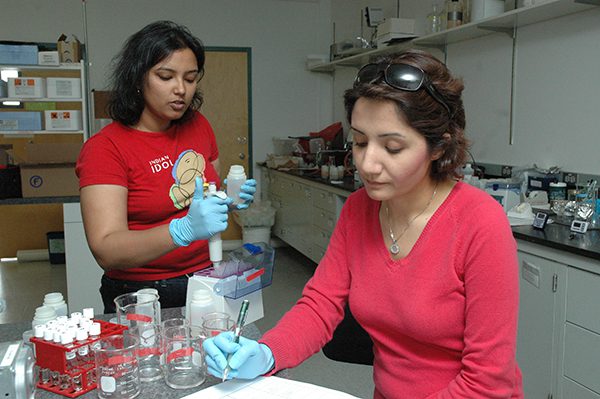
As the director of IDEAS, Hilger helped define the mission of the new research center.
“We provided regional leadership to accelerate a cultural and technological shift to more sustainable practices,” Hilger said. “We fostered dynamic and strategic research collaborations among multiple university disciplines, promoted a region-wide climate of cooperation, and provided students a knowledge base and experience that allowed them to contribute to these advances.”
Funding of IDEAS project came from multiple sources, including the U.S. Department of Energy, the National Science Foundation, the NC Biofuels Center, the NC Green Building Fund, Charlotte Mecklenburg Utilities, Mecklenburg County LUESA (Land Use and Environmental Services Agency), the Water and Sewer Authority of Cabarrus County, the UNC Charlotte Lee College of Engineering and various private companies.
“Our projects ranged from complex infrastructure systems and residential housing developments, to material science investigations and stream restoration, to renewable energy technologies and global partnerships that enabled technology transfers,” Hilger said. “Because of the diverse dimensions of sustainability, effective research teams had to be cross disciplinary. The IDEAS Center provided UNC Charlotte with a critical mass of investigators who could solve sustainability challenges of local, national and international significance.”
Examples of IDEAS research included a $500,000 U.S. Department of Energy project to develop novel reuse of reclaimed construction and demolition wastes; research initiatives to look at algae as a means for nutrient removal at wastewater treatment plants, after which the algae could be used as feedstock for digesters-to-methane or for burning; with funding obtained from the NC Biofuels Center ($100,000) and the NC Green Business Fund ($85,000) the development of advanced plans for a tightly integrated system to make biodiesel from crops and brown grease; design and planning of a high-performance mixed-use development in Gaston County; and a project to reclaim waste material from construction sites, produce fertilizer from it and use the fertilizer to increase the yield of plants for use in biodiesel.
Academics
IDEAS research projects brought value not only to the project sponsors, but also to the graduate and undergraduate students who worked on them. The classroom and teaching aspects of IDEAS were of great importance to Hilger and her team.
“Teaching and research go hand-in-hand,” Hilger said. “When I taught, my number-one focus was hooking the students. If I could get them hooked, they would learn on their own. When you were sending out 50 kids a year with your message and an understanding of your mission you had a lot of power. And the students had a lot of power to do good.”
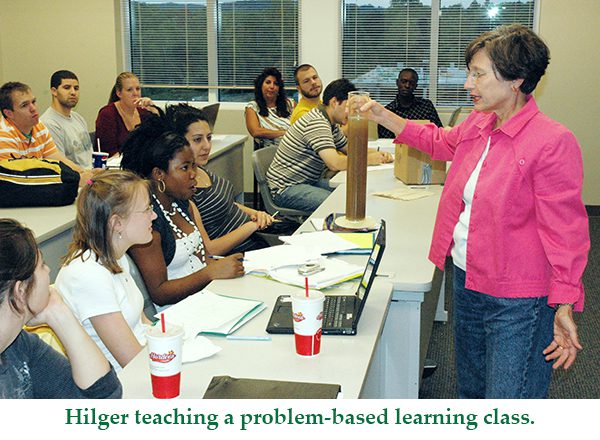
In her teaching, Hilger pioneered a problem-based learning approach where students worked on team projects and didn’t just attend lectures and labs. “It was very hard to do, and very time consuming designing the projects,” she said. “You had to convince students that working on teams was a good thing and that you learn as much from failing as you do from succeeding.”
The overall environmental philosophy that Hilger strove to teach her students was the importance of sustainability over time. “Everything comes from the earth, from natural systems,” she said. “The earth provides lots of free services such as air filtration, water filtration, bees that pollinate and other things that are all free and we don’t even notice them. When you mess around with these natural services, though, you run the risk of losing them. And getting them back doesn’t come cheap. Climate change is one example of something we messed with and the balance is now out of control. What I wanted the students to understand is that everything is intimately related.”
Environmental Assistance Office
As an industrial outreach and experiential learning center designed to connect the environmental engineering and science expertise of UNC Charlotte with external public and private partners, the Environmental Assistance Office (EAO) was an important part of IDEAS. EAO served multiple regulatory agencies, small businesses, and state agencies with research projects, conferences, educational support and outreach. It employed more than 20 students each year who received “green jobs” training under the guidance of faculty and staff.
“EAO provided non-regulatory, client-confidential pollution prevention assistance,” said Executive Director Regina Guyer. “The mission of our office was to increase effective and sustainable pollution prevention practices in the region and provide our students with out-of classroom experiences. “
Interdisciplinary researchers from civil engineering, chemistry, biology, computer science, English, Health and Human Services and the INES program participated in EAO projects.
“The project nature of our work provided students with practical learning opportunities,” Guyer said. “We emphasized interdisciplinary teamwork and created customized teams to meet our partners’ needs. Students were involved in multiple aspects of project development and execution.”
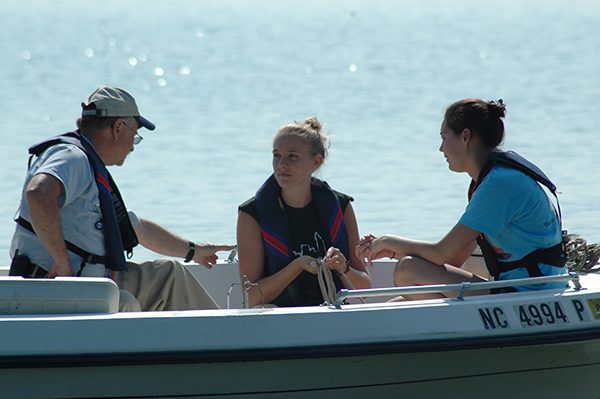
EAO partnered with agencies such as Charlotte-Mecklenburg Utilities on the investigation of sewer system loading and treatment process evaluations; the Mecklenburg County Land Use and Environmental Services’ Air Quality Division on a project to promote clean air and provide research reports and outreach activities and small business assistance; and the Solid Waste Division to provide environmental assessment on the performance of recycled concrete aggregate for erosion control, and on recycled gypsum wall board used as a soil amendment.
Another major EAO activity was its annual BioEnergy Symposium, which brought together municipal decision makers, regulators, citizen advocacy groups and interested residents to engage in dialogue on various bioenergy issues, such as waste-to-energy and biofuels technology. By developing understanding of how the synergies of these applications could be brought to fruition for sustainable and economically viable systems, the conference sought to develop bioenergy solutions with beneficial byproducts, achievability and applicability, and technological innovation.
In 2013, EAO was reorganized under UNC Charlotte’s Energy Production and Infrastructure Center, and was renamed the Energy and Environmental Assistance Office (EEAO). The new mission of EEAO was to serves as an important communication, dissemination and educational link between EPIC and the community at large to build collaborations. EEAO projects included research in air quality, solid waste, energy, structures, water, and sustainability and environmental issues. EEAO also added a recharge unit to its list of services, which allowed research and general services to be offered by the EPIC team with an ease of implementation for clients.
New IDEAS
When Hilger retired from UNC Charlotte in 2012 she left with the expectation that IDEAS would continue to be involved in projects of importance to the environment and sustainability efforts of the Charlotte region. “As it defines its relationship with EPIC, I expect the IDEAS Center to continue to florish,” Hilger said.
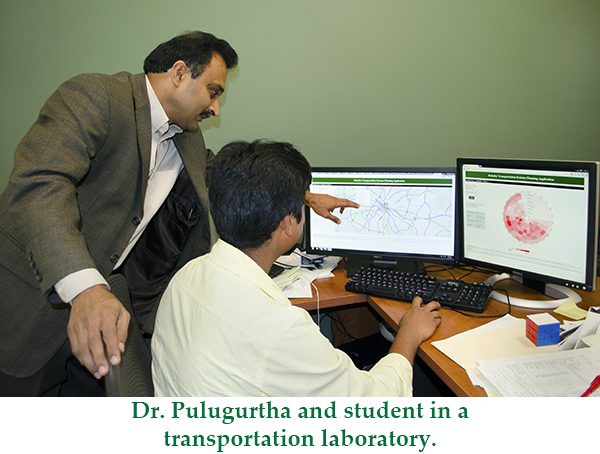
Dr. Srinivas Pulugartha became the new director of IDEAS in 2013. An expert in the area of transportation, Pulugartha brought and increased focus on transportation research, adding to IDEAS’s capabilities in environmental engineering and materials. IDEAS transportation research included a number of projects for the North Carolina and U.S. departments of transportation. New NCDOT research grants totaled almost $1.4 million in 2014.
Working with the Civil and Environmental Engineering Department, IDEAS initiated a course in railway engineering. Collaboration was also built with the rail program at the University of Birmingham in England, with UNC Charlotte students visiting there, and Birmingham faculty coming to Charlotte.
IDEAS continued to expand into additional multidisciplinary work with both on-campus and off-campus collaborators. The strength of IDEAS through its collaborations enabled it to secure funding from the Department of Energy for the Streamlined Weatherization Innovation for Tomorrow (SWIFT) project, and from the NSF for the Industry/University Cooperative Research Center for Sustainable Integrated Buildings and Sites (SIBS). As a sustainability-oriented center, SIBS was the first of its kind in the region to offer the integrated expertise of architecture, building science, site design and natural system science.
Other new projects included a NSF funded Social Sustainability Network Group, and a Water Resource Research Institute funded project to study ecosystem dynamics and communications strategies for the Urban Water Consortium. The NC Department of Commerce’s Energy Division and the City of Charlotte funded a State Energy Interns and Fellows program. The IDEAS Center also focused on providing services and workforce development for students via the Environmental Assistance Office. About 20 students became involved with projects on sustainability, energy, and environmental topics to strengthen their learning experiences on campus and their career skills.
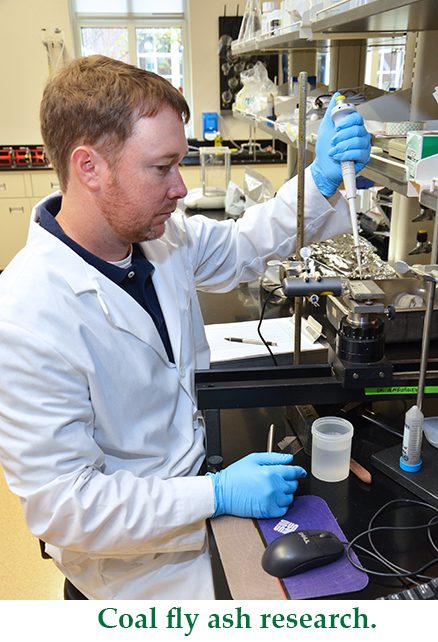
Another area where IDEAS and Civil Engineering researchers began to take a regional and national leadership role was in coal fly ash. Electric utilities had experienced a number of failures in their traditional methods of storing coal ash, and UNC Charlotte researchers brought to bear their expertise in the containment, stabilization and re-use of the waste material. With nine faculty members involved and state-of-the-art testing facilities, IDEAS faculty researchers and their students partnered with industry and regulators to look at ways to re-use, safely store and reduce the leachability of coal ash.
The Future
For the years beyond 2015, IDEAS leaders were committed to tightly integrating their work with undergraduate and graduate education programs so that graduates understood the challenges and could contribute to 21st century solutions and advances. Research topics that would be addressed included earth systems and climate change; natural and engineered water systems; low-impact materials and material reuse and recovery; building systems and community design; transport optimization; business, economic, policy and regulatory issues; system modeling and assessment; and international/transboundary issues related to sustainable development.